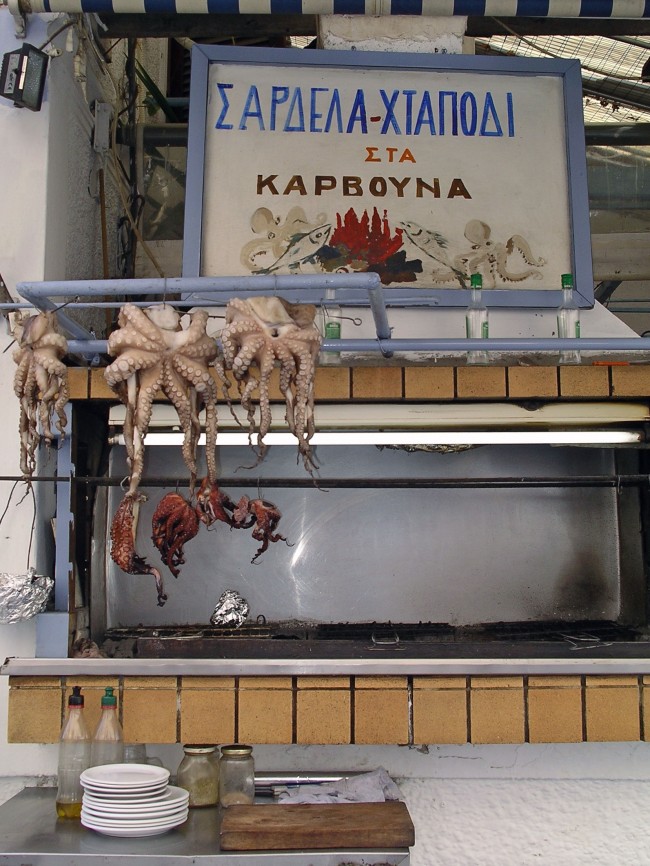Crete, the southernmost island in Europe, is a highly desirable vacation destination for many reasons. Bathed in clear sunlight much of the year, the climate is one of the best in Europe. It has magnificent mountain ranges, long sandy beaches, rocky bays, tranquil villages and the scent, the marvellous scent of wild sage, rosemary and thyme that drifts down from the hills is unforgettable. Crete also makes some of the world’s best olive oil and is known for its healthy Cretan cuisine. And, Crete is an archaeologist’s paradise. I’m not usually drawn to the old and dusty, but with remnants of ancient civilizations commonplace throughout the island, I looked forward to poking around the ruins.
Home base was Hersonissos, a once valued trading center that juts into the bay of Malia, 26 km east of Crete’s capital, Heraklion. In the high season it’s a popular destination for party animals thanks to the clubs and a robust nightlife. In the off season, most of the restaurants and clubs are closed and it is a quiet village of only 4000 inhabitants, perfect for those of us who are more interested in exploring the ruins by day and resting up at night. I was surprised to discover that even sleepy Hersonissos has its share of antiquities and boasts many easily accessed remnants of Roman dominance.
One morning I watched in awe as workers installing water pipes on the main street unearthed several large, centuries-old pottery storage jars (called pithos). Without a second glance, they set them to the side of the road and then continued on with their work. The next day the jars were gone, presumably hauled off to an artifacts warehouse somewhere. Not far from the harbour there was very large odd looking square stone structure decorated with mosaics depicting fish and fishermen. It turned out to be an early Roman fountain. Like many other towns in Crete, archaeological findings to admire are commonplace and scattered throughout the area.
Knossos
The most important attraction in Crete is the famous Minoan Palace of Knossos. This archaeological site is a magnet for history buffs and Greek mythology enthusiasts alike. In the half hour bus ride from Hersonissos, our guide Effie, told us that much of Greek Mythology originates in Crete. She said, “It is said that the god Zeus was born in a cave in Crete; Crete is where Theseus fought the monstrous Minotaur in the Labyrinth, and where Icarus’s waxen-winged attempt to fly from the wrath of King Minos ended in disaster. Then, there is the story of Zeus who was married to the goddess Hera. But, he was so smitten with Europa, the daughter of the King of Phoenicia, he disguised himself as a bull and spirited her away to Crete. Legend has it that King Minos who ruled Knossos is the child of the union between Zeus and Europa. Myth or reality? We’ll never know. Knossos was destroyed about 1450 BC, likely due to a catastrophic volcanic eruption, and precious little is known about the Minoans.
Upon arriving at Knossos, I wasn’t prepared for what I saw. While most archaeological sites are just foundations of long gone structures, much of Knossos has been reconstructed. In fact, the place doesn’t look all that ancient. The columns and frescoes have an almost glossy, just done look about them, perhaps more like an aging movie set…too bright and too fresh looking. Effie pointed out, “There has been much controversy about the restorations here. They reflect how archaeologist Sir Arthur Evan’s thought Knossos would have looked during Minoan times. Much of the site is restored with techniques condemned by modern day archaeologists, such as the use of concrete”. Though Knossos seemed rather “tarted up” to me, it makes it easy to transport yourself within the frescoed walls and red pillars to imagine the glamour and splendour that must have been the Minoan world.
There are many more ruins in Crete to explore than I had time for. What I learned is that for every archaeological site there seems to be two stories…the real one and the mythical. For me, it’s the mythical that drew me in. After all, aren’t holidays supposed to be an escape from reality?


